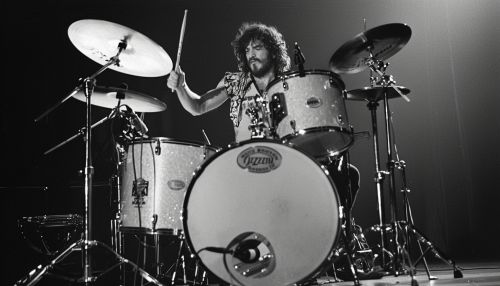John Bonham
Early Life and Background
John Henry Bonham, commonly known as John Bonham, was born on May 31, 1948, in Redditch, Worcestershire, England. He was the son of Joan and Jack Bonham, who worked as a carpenter. Bonham showed an interest in music from a young age, often banging on household items to create rhythms. His mother bought him a snare drum when he was ten years old, and by the age of fifteen, he had his first drum kit.
Bonham attended Lodge Farm Secondary Modern School, where he met future bandmate Robert Plant. He left school at sixteen and worked for his father while playing in local bands. His early influences included jazz drummers like Gene Krupa and Buddy Rich, as well as rock drummers such as Ginger Baker and Keith Moon.
Career Beginnings
Bonham's professional career began in the mid-1960s when he joined the band Terry Webb and the Spiders. He later played with other groups, including A Way of Life and The Nicky James Movement. His powerful drumming style quickly gained attention, and he became known for his speed, power, and technical skill.
In 1968, Bonham joined the blues group Band of Joy, which also featured Robert Plant. The band toured extensively and recorded several demos, but they disbanded in early 1968. This period was crucial for Bonham's development as a drummer, as he honed his skills and developed his signature style.
Led Zeppelin
Formation and Early Years
In 1968, guitarist Jimmy Page was forming a new band and invited Bonham to join. Along with Robert Plant and bassist John Paul Jones, they formed Led Zeppelin. The band's debut album, "Led Zeppelin," was released in 1969 and was an immediate success. Bonham's drumming was a key component of the band's sound, characterized by its power, precision, and creativity.


Musical Contributions
Bonham's drumming was integral to Led Zeppelin's music. He was known for his innovative use of triplets, his ability to maintain a steady groove, and his dynamic playing. Some of his most famous performances include the drum solo "Moby Dick" and the complex rhythms of "Good Times Bad Times."
Bonham's use of the bass drum was particularly notable. He often played with a single bass drum, using a technique known as the "heel-toe" method to achieve rapid double strokes. This technique allowed him to create powerful and intricate patterns that became a hallmark of his style.
Influence and Legacy
Bonham's influence on drumming is profound. He is often cited as one of the greatest drummers in rock history, and his techniques have been studied and emulated by countless drummers. His work with Led Zeppelin set new standards for rock drumming, and his contributions to the band's music continue to be celebrated.
Personal Life
Bonham married Pat Phillips in 1965, and they had two children, Jason and Zoë. Jason Bonham followed in his father's footsteps and became a successful drummer, often performing with Led Zeppelin in reunion concerts.
Despite his success, Bonham struggled with alcohol abuse, which ultimately led to his untimely death. He died on September 25, 1980, at the age of 32, after a day of heavy drinking. His death marked the end of Led Zeppelin, as the band decided they could not continue without him.
Drumming Style and Techniques
Bonham's drumming style was characterized by its power, precision, and creativity. He was known for his ability to play complex rhythms with ease and his innovative use of the bass drum. His drumming on tracks like "When the Levee Breaks" and "Kashmir" showcased his ability to create a powerful and driving groove.
Bonham often used a Ludwig drum kit, and he was known for his use of large drums, including a 26-inch bass drum. His use of triplets, ghost notes, and syncopation added depth and complexity to his playing. He also incorporated elements of jazz and funk into his drumming, creating a unique and influential style.
Equipment and Setup
Bonham's drum setup was an essential part of his sound. He primarily used Ludwig drums, including a 26-inch bass drum, 14-inch snare, 16-inch and 18-inch floor toms, and a 15-inch rack tom. He also used Paiste cymbals, including a 24-inch ride, 16-inch and 18-inch crashes, and 15-inch hi-hats.
His choice of sticks was also notable. Bonham used large, heavy sticks, often referred to as "tree trunks," which contributed to his powerful sound. He was known for his ability to tune his drums to achieve a deep and resonant tone, and he often used microphones to capture the full range of his playing.
Legacy and Recognition
John Bonham's legacy as a drummer is enduring. He is widely regarded as one of the greatest drummers in rock history, and his influence can be heard in the playing of countless drummers across various genres. His work with Led Zeppelin continues to be celebrated, and his drumming remains a benchmark for excellence.
Bonham has been posthumously inducted into the Rock and Roll Hall of Fame as a member of Led Zeppelin, and he has received numerous accolades for his contributions to music. His innovative techniques and powerful playing have left an indelible mark on the world of drumming.
